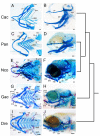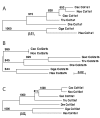Molecular pedomorphism underlies craniofacial skeletal evolution in Antarctic notothenioid fishes
- PMID: 20053275
- PMCID: PMC2824663
- DOI: 10.1186/1471-2148-10-4
Molecular pedomorphism underlies craniofacial skeletal evolution in Antarctic notothenioid fishes
Abstract
Background: Pedomorphism is the retention of ancestrally juvenile traits by adults in a descendant taxon. Despite its importance for evolutionary change, there are few examples of a molecular basis for this phenomenon. Notothenioids represent one of the best described species flocks among marine fishes, but their diversity is currently threatened by the rapidly changing Antarctic climate. Notothenioid evolutionary history is characterized by parallel radiations from a benthic ancestor to pelagic predators, which was accompanied by the appearance of several pedomorphic traits, including the reduction of skeletal mineralization that resulted in increased buoyancy.
Results: We compared craniofacial skeletal development in two pelagic notothenioids, Chaenocephalus aceratus and Pleuragramma antarcticum, to that in a benthic species, Notothenia coriiceps, and two outgroups, the threespine stickleback and the zebrafish. Relative to these other species, pelagic notothenioids exhibited a delay in pharyngeal bone development, which was associated with discrete heterochronic shifts in skeletal gene expression that were consistent with persistence of the chondrogenic program and a delay in the osteogenic program during larval development. Morphological analysis also revealed a bias toward the development of anterior and ventral elements of the notothenioid pharyngeal skeleton relative to dorsal and posterior elements.
Conclusions: Our data support the hypothesis that early shifts in the relative timing of craniofacial skeletal gene expression may have had a significant impact on the adaptive radiation of Antarctic notothenioids into pelagic habitats.
Figures






References
-
- Eastman JT. The nature of the diversity of Antarctic fishes. Polar Biol. 2005;28:93–107. doi: 10.1007/s00300-004-0667-4. - DOI
-
- DeWitt HH. In: Antarctic Map Folio Series. Bushnell VC, editor. Vol. 15. New York: American Geographical Society; 1971. Coastal and deep-water benthic fishes of the Antarctic; pp. 1–10.
-
- Eastman JT. Antarctic Fish Biology: Evolution in a Unique Environment. San Diego: Academic Press; 1993.
-
- Eastman JT, Clarke A. A comparison of adaptive radiations of Antarctic fish with those of non-Antarctic fish. Milano: Springer-Verlag; 1998.
Publication types
MeSH terms
Grants and funding
LinkOut - more resources
Full Text Sources
Molecular Biology Databases

